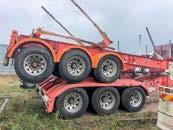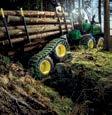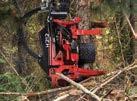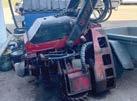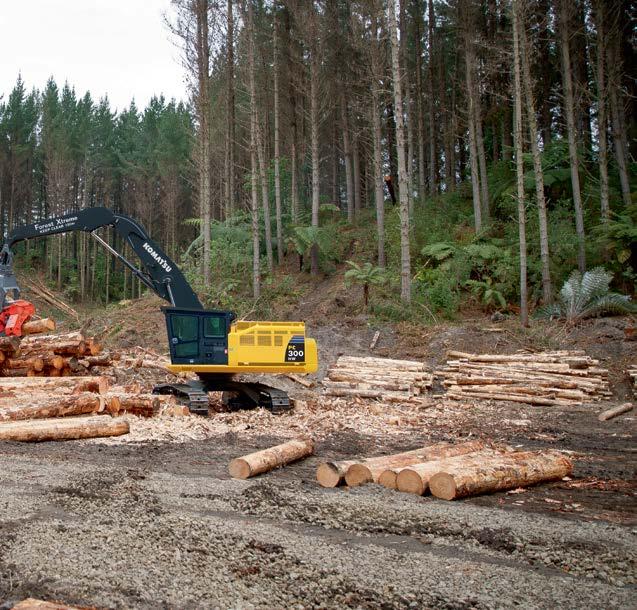GOING ELECTRIC CUTTING A NEW PATH FOR CARBON-FREE FORESTRY


LEADERSHIP CHANGE AT

GOING ELECTRIC CUTTING A NEW PATH FOR CARBON-FREE FORESTRY


LEADERSHIP CHANGE AT
ARE YOU SICK OF WAITING FOR HOSE REPAIRS?

PONSSE HARVESTING AND PROCESSING HEADS are widely used in track and rubber tired harvesters worldwide.


PONSSE has been designing and manufacturing harvester heads for 30 years. The long-term experience and active listening of customer feedback shows in the products – every model is at the top of its class in productivity and reliability.

DURABILITY WITH LOWER WEIGHT is ensured by using well-designed structures and highest quality steel. Saw is quick and precise, feeding fast and strong, making our heads productive.
MORE CUBIC METER PER HECTARE with PONSSE Opti control system designed for PONSSE heads.
Australia’s first electric log truck has arrived in Mount Gambier, as Fennell Forestry cuts a new path towards a carbon-free future for the sector.
The truck is just the second electric log truck in the world and has been commissioned by the Green Triangle-based local harvest and haulage company to provide a realistic carbon reduction solution for the heavy transport industry.
Fennell Forestry unveiled the truck to stakeholders, government and industry representatives at an exclusive preview event in Mount Gambier.
Work to convert the once diesel-powered Kenworth prime mover to a fully electric battery operating system has been underway since early-2022, driven entirely by Australian technol-
● 100% carbon zero when recharged using renewable energy.
● Existing vehicle conversion. Battery charging technology and operating system installed on an existing truck, allowing reuse of the Kenworth prime mover chassis, axles and suspensions required for Fennell Forestry transport operations.
● Four hours for full battery recharge, using the newly established on-site charging station.
● “Swap-and-go” battery system, which requires the truck to be stationary for less than five minutes.
● 400-500km indicative battery range, dependent on operation type.
● Low engine running temperature 40 degrees less than regular diesel engines.
● 720 horsepower and rated to meet the GCM requirements of Fennell Forestry B-Doubles.

ogy, innovation and workmanship.
And after rigorous testing, fine-tuning and anticipation, the truck is now at home in Australia’s most productive plantation forestry region - the Green Triangle.
The EV has a predicted range of 400 to 500 kilometres on a full charge, but its capabilities will be tested during the trial.
A full battery charge takes four hours, but with a swap-and-go system only five minutes is needed to change the batteries using a forklift.
With only one location for this swap to take place, however, the truck will have to travel within the region.
A new charging station has been installed and tested at Fennell Forestry’s Mount Gambier depot, to ensure the vehicle can be operated and recharged as required.
On-road and in-field preliminary testing has been carried out to ensure the truck can handle the demands of forest logging. Staff inductions have been held, plantation managers briefed and local emergency service crews have also previewed the new technology, ensuring everyone is ready when the truck finally hits the road.
The electric vehicle (EV) will undergo two years of testing to check its performance and to see if maintenance costs stack up against traditional internal combustion engines.
Fennell Forestry Managing Director Wendy Fennellup to the theoretical. We think it will, but will be two years before we can say our Australia-first initiative has been a success.
“It’s an educated gamble, but one we feel compelled to take for the benefit of the heavy transport industry and future generations.”
Transport is Australia’s second highest contributor to carbon emissions. A single diesel-powered log truck produces in excess of 500 tonnes of carbon every year.
ing electricity as an energy source,” Janus Electric chief executive Lex Forsyth said.
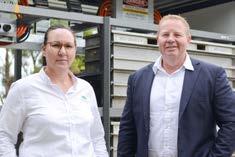
“Australia has unique operating conditions, harsh environments from cold to hot … we’re such a remote country, the tyranny of distance is a huge,” Mr Forsyth said.
“So it’s about putting the technology to test in real world applications that suit Australia, for the Australian operators.”
said the electric truck represented the first bold step towards ensuring heavy transport industry meet the Federal Government’s 2030 emissions reduction targets.
“We’ve done our groundwork and due diligence, calculating battery power, run time and carbon-emission reduction,” she said.
“Now it’s time to get the truck loaded and on the road to see if the practical application measures
Converting to an electric engine and battery system will slash this number to zero. And when recharging using renewable energy, the environmental dividends will be even greater.
Australian company Janus Electric, to comply with the high gross combination mass requirements of Australia’s heavy transport vehicles, has completed the electric conversion in New South Wales.
“We saw this as a real opportunity to help transport industry decarbonise and also get some control of their costs back with us-
He believed this launch would be the first of many in Australia.
“I think this this is the technology for the future,” Mr Forsyth said.
“I think in 10 years time if we [Janus Electric] haven’t got 15 to 20 per cent of the Australian market, we haven’t done our job properly.”
No government funding was provided to the project but SA Minister for Primary Industries and Regional Development Clare Scriven said she would need to see the results before committing to any future investment.
We’ve been a leading force in air flow design for almost 3 decades, with 4-, 6-, 8-, and 12-bladed propellers, designed and manufactured exclusively for the lumber industry. Now, they are even more capable with higher- temperature capacity for certain applications. We combine this technology with unsurpassed customer service, design consultation and technical expertise, so whatever your air flow need, you can trust SmithCo to deliver.
APRIL 2023
Issue 2 – Volume 34
Established 1991
News 6 - 13
Round Table 7-9
Private forests: 14-15
Mill technology 20
Excavators 16-17
Silviculture 24
Front Cover: Australia’s first electric log truck has arrived in Mount Gambier, as Fennell Forestry cuts a new path towards a carbon-free future for the sector. The truck is just the second electric log truck in the world and has been commissioned to provide a realistic carbon reduction solution for the heavy transport industry. Picture: Laura Thomas
Publisher and Chief Executive:
Hartley Higgins
General Manager:
Robyn Haworth
Editor:
Bruce Mitchell
b.mitchell@ryanmediapl.com.au

Adelaide Office: (08) 8369 9512
Advertising:
Adelaide Office: (08) 8369 9517
Creative Services:
Tim Coleman
Publication Design:
Tim Coleman
Trader classifieds:
Adelaide Office: (08) 8369 9517
Subscriptions: subs@forestsandtimber.com.au
Adelaide Office: (08) 8369 9522
Subcription rates
One-year (8 editions) $55
Two-years (16 editions) $95
Accounts: (03) 5723 0100
Postal Address:
630 Regency Road, Broadview South Australia 5083
Phone: (08) 8369 9555
Fax: (08) 8369 9501
Melbourne Office: Suite 2262, 442 Auburn Rd, Hawthorn VIC 3122
Phone: (03) 9810 3262
Website www.timberbiz.com.au
Printed by Lane Print, Adelaide, SA
Conditions
The opinions expressed in Australian Forests & Timber News are not necessarily the opinions of or endorsed by the editor or publisher unless otherwise stated. All articles submitted for publication become the property of the publisher.
All material in Australian Forests & Timber
News copyright 2022 © Ryan Media.
All rights reserved. No part may be reproduced or copied in any form or by any means (graphic, electronic, or mechanical including information and retrieval systems) without written permission of the publisher. While every effort has been made to ensure the accuracy of information, the published will not accept responsibility for errors or omissions, or for any consequences arising from reliance on information published.
Our native timber forest industry is on the verge of a total shutdown with the Andrews Labor Government’s reluctance to stop third party interference decimating this once proud industry that was the backbone of our rural and regional communities in Victoria.
The reluctance of the Andrews Labor Government to change the Code of Practice so that third party pests stop interfering with VicForests proves to me that the Andrews Labor Government does not govern for all Victorians.
Following the news that Maryvale would cease white paper production and hundreds of jobs would be lost, Victorian Greens Leader, Samantha Ratnam, posted on her Facebook page on the 21st of February that the Greens would immediately table a Bill in Parliament to put a stop to all native timber forest harvesting from June 2023. All because the decision proved native tim-
ber was no longer needed.
It is extremely frustrating to read such comments from someone who does not live in regional Victoria, who obviously does not care about regional Victoria, and has forgotten that Maryvale production of white paper has only ceased because of the lack of supply. It’s like trying to justify what came first, the chicken or the egg and using it to score political points.
My predecessor, Gary Blackwood, who has been a strong advocate for the na-
tive timber forest industry for many years has tried to educate government on this industry. In Parliament he’s proven time and time again that this industry has a future in Victoria and can contribute to the reduction of carbon.
What concerns me if this industry is shut down is what happens to our smaller communities across regional Victoria.
The ones who in the past have relied on this industry in their hometowns. This industry has supported sporting clubs, community groups, pubs, local businesses and put food on families’ tables for generations.
Will these towns now become ghost towns and what happens to their future?
Will harvesters, contractors, haulage operators or mill workers qualify for an assistance or support?
This Government has a history of failing to support workers when there is a collapse or forced closure, you only have to look at Ha-
zelwood and their failure to support and retrain workers.
Local communities are rightly asking where are the two Labor Members of Parliament who represent the Gippsland region?
If this government is not brave enough to protect this industry, then this government should compensate everyone in the industry for loss of earnings and loss of future earnings until 2030 which is what they guaranteed them in the first place.
I will continue to fight for the native timber forest industry like my predecessor Gary Blackwood and I will hold this government to account to every worker and family that has been affected by the gutlessness of this Andrews Labor Government.
Wayne Farnham was elected at the 2023 supplementary election for the seat of Narracan replacing the retiring Gary Blackwood.
So, now we know for certain what it means when a politician – in this case a potential prime minister – makes a promise. It means zip. But we all pretty much knew that anyway.
In this case it was then Opposition Leader, Anthony Albanese, who told forestry workers in Tasmania in May last year that: “I promise you that if I become Prime Minister, a Government I lead will not shut down the native forestry industry.”
The very concept of a Federal Government excluding the forestry industry from a manufacturing strategy, Mr Albanese said at the time, as “shameful”.
And how has the PM been caught out? The announcement that a deal had been struck deal between the Greens and the Federal Government to ban the National
Reconstruction Fund from direct investment in native logging projects. Oil and gas, of course, also miss out.
The Bill passed the lower house after about two hours of debate and will now go to the Senate, where the Greens hold the balance of power.
The legislation would have passed the lower house even without the Greens’ support given Labor holds most of the seats in the chamber.
But it will be a different story in the Upper House, where the government doesn’t hold a majority and needs to secure the backing of the Greens and at least two crossbenchers in order to pass any legislation the Coalition doesn’t support.
The decision to exclude logging from any fund-
ing has angered reportedly Tasmanian senators Jacqui Lambie and Tammy Tyrrell, who are both crossbenchers.
“Giving in to the Greens’ demands is a smack in the face to Tasmanians,” Senator Tyrrell was reported as saying.
“The prime minister needs to come out and explain this about face.”
He does indeed, but the truth is he probably won’t.
In their original NRF plan, the Albanese Government pledged that $500 million would be reserved specifically for support across the agriculture, fisheries and forestry sectors. This was a centrepiece of their preelection promises to the forestry industry.
It might be a bit trite to point out, but in terms of what the Greens have “achieved” in this country
so far in terms of native timber do they not realise that materials like hardwood and paper will be now be imported from countries many of which have far less environmental controls over logging, and on fossil fuelburning ships and planes?
Obviously not, but political points have been scored, and it seems that’s all that matters.
Australian Forest Products Association CEO Joel Fitzgibbon quite rightly described it as “a shameful victory for politics over sensible policy”.
Mr Fitzgibbon said it was time to “start staring the Greens down”.
It is indeed, but which Federal or State government has the political will to do it?

Dr Michelle Freeman has been elected President and Jim Wilson Vice President of Forestry Australia.
Retiring President, Bob Gordon applauded the move stating he was delighted to see Michelle and Jim join with the organisation’s CEO Jacquie Martin, to form a diverse leadership team, as part of the Board transition and renewal process.
“It is heartening to see Michelle accept the nomination to take the leadership of the team, particularly on the eve of International Woman’s Day,” Mr Gordon said.
“Michelle has been on the Board for a number of years and has already made a very significant contribution to Forestry Australia and I look forward to her leadership,” Mr Gordon said.
Michelle is a forester with a passion for native forest management and has a double degree in Forestry and Science (Ecology), and a PhD from the University of Melbourne.
Her PhD was in partnership with CSIRO Darwin looking at savanna fire and tree dynamics of northern Australia, as part of the Tiwi Carbon Study.
Michelle is a Registered Forestry Professional and has worked in timber harvesting operations, planning and regulation and is currently Principal Consultant and Director of Hollowwood Enterprises.
She was on the Board of the IFA from 2012 – 2014, and chaired the Future Foresters Initiative from 2015 –2017. From 2014 – 2017 she was an Independent Council Member on the Federal Governments’ Forest Industry Advisory Council, a past Board member of FSC Australia/NZ, and is a graduate of the Australian Institute of Company Directors.
Michelle is joined by Vice President, Jim Wilson who has a Bachelor of Science (Forestry) Australian National University 2003 and is the Plantation Operations and Services Manager at Forico, Tasmania.
He is a Registered Forestry Professional and graduated from the Australian Institute of Company Directors and Australian Rural Leadership Program.

Jim’s career has been focused in the private sector and he has invested his recent years working with Forico, as well as providing significant service at sector level in advocacy and leadership.
Jim is also an active farm forester with both plantation and native forest in Tasmania.
Bob Gordon will remain on
the Board during this transition period.
AFPA Chief Executive Officer Joel Fitzgibbon said Bob Gordon had led a distinguished career in many fields, not least of which includes his service to Australia’s forestry sector.
“I’ve had the privilege of working with Bob over the course of the last twenty years,” he said.
“I look forward to working with both Michelle and Jim to meet the forestry sector’s policy challenges and opportunities, including shoring up future timber and wood fibre supply to achieve sovereign capability, having industry contribute to Australia meeting its climate goals and continually improving evidence based approaches to forest management,” Mr Fitzgibbon said.

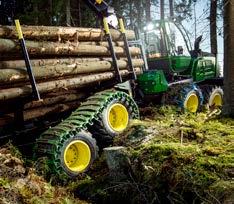
It’s a long way from the battleground of Waterloo where Napoleon met his match, to the pine forests of the Green Triangle.
However it is the Dohnt family’s journey.
Today L.V. Dohnt & Co is one of Australia’s largest infield chipping companies with the main production service areas being the south-east of South Australia, Western Victoria and the Great Southern Region of Western Australian.

The family arrived in South Australia from Prussia in 1839, with Gottfried Dohnt seeking a better life after having fought in the Battle of Waterloo with the Prussian Army alongside the British when they defeated Napoleon and his French army in 1815.
Lawrence Victor Dohnt, the great grandson of Gottfried, founded the company in 1932 and was one of the first logging contractors for the Woods and Forests Department at Bundaleer in South Australia’s mid north.

In 1937 they obtained their first contract, with the SA Woods & Forests Department, to transport pine logs
from the Government forests to the Penola sawmill of Alf Donnelly. This original contract was for 2,700 m3 per year, and now they infield chip over 1.2 million GMT per year.
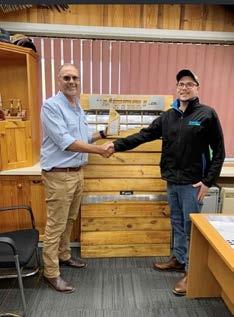
Following the initiation of a second contract, Lawrence moved his family and the company to the South East of South Australia to supply logs from thinnings to a temporary mill at Penola and then supplying the Nangwarry Sawmill in 1940.
Now 90 years later, the company mainly concentrates on in-field chipping in both blue gum and pine plantations. These operations make up about 80 per cent of the company’s business which employs about 120 people nationally with about 75-80 in the Green Triangle region and a further 70 to 75 in Western Australia.
The company is now being run by Mark Dohnt
with father Phillip retaining ownership and the title of managing director.
Mark began in the business working after school and in his school holidays in the workshop.
And cleaning up the workshop, he then moved into operating machinery in the school holidays. When he finished high school he went full time operating skidders and feller bunchers until he worked his way into a team leader position.
Supervisory positions followed and then Mark moved to Western Australia as Operations Manager in Albany, then state manager in Western Australia before returning to Nangwarry in 2021.
Then Covid happened and as with the rest of the country everything kind of ground to a halt.
Mark says that since the pandemic the company has had a lot of trouble with transport.
“We’ve bought five new prime movers in the last few months, and we’ve got some more on order,” he said.

But driver shortages remain a huge problem Australia wide.
“There’s plenty of work. There’s a lot of work opportunities. So that’s not an issue at all,” he said.
But obtaining new equipment from overseas remains an issue.
“It’s 12 months if you want to order a chipper or a truck or trailer,” Mark said.

“There’s opportunities to expand but we’re not taking it on because we can’t get the equipment. We can’t get the people or the maintenance staff to do it. And parts are becoming an issue as well.”
Mark doesn’t see any quick fix.
“I reckon at least two-plus years away,” he said.
Phillip has retired from the Australian Forest Contractors Association board but the company remain members.
Mark believes there's value there to be the part of the
organization.
“They’ve had a fair bit of input into things like the Victorian government trying to shut down old-growth forests,” he said.
“The new CEO (Carlie Porteous) knows what she’s doing.”
Ensuring Australia realises the Federal Government’s goal of planting one billion new timber trees by 2030 is critical to securing Australia’s future timber and wood fibre needs, maintaining our sovereign capability, and achieving net zero emissions by 2050.
If we don’t locally produce our raw materials to make structural timber, home furnishings like floorboards and timber benchtops, packaging and paper, furniture and even toilet paper, we become more exposed to volatile import markets in an increasingly uncertain and wood fibre constrained global economy, while sacrificing local industry. It all comes back to making sure we have enough timber trees growing in the ground. The billion trees policy was first committed to by the Federal Coalition Gov-
ernment in 2018, in its National Forest Industries Plan.
Since then, it has been bipartisan national policy, carrying through to today under the Albanese Government which recommitted to the goal during the

The voice of Australian forest contracting businesses for over 20 years!

2022 election campaign. Disappointingly, since the launch of the plan we have actually gone backwards in our plantation estate, and we have seen the Western Australian and Victorian governments announce the closure of their native timber industries which will put even more pressure on our already-constrained plantation resource to meet Australia’s future wood fibre needs.
Recent AFPA and Master Builders Australia modelling warns that failure to grow our plantation estate will result a national demand shortage the equivalent of 250,000 house frames worth of timber by 2035. That’s the equivalent number of dwellings as the cities of Newcastle and Geelong combined, which will mean more timber shortages, and even greater reliance on timber imports.
AFCA advocates on behalf of our members to improve their business outcomes and the sustainability of our working forests, serving the industry and our members since 2002

AFCA engages with government industry stakeholders and the community to represent the interests of our members We play an important role in ensuring members the forest industry supply chain and governments are aware of developments and best practices for a viable forest industry and future AFCA is here for our members to ensure they have an organised and strong representative voice both within the industry and at all levels of government
Add to this that global demand for timber and wood fibre is increasing hugely: by 2050 demand is forecast to be four times higher than today.
It should be clear to all decision makers that the risks of not achieving the goal are significant, and a matter of national importance.
However, all hope is not lost. There are huge opportunities for Australia to plant more timber trees for both domestic and international consumption. We are on the cusp of an amazing sunrise in global demand for timber and wood fibre.
The Federal Government will soon open its $86 million Plantation Expansion Grants program which will support new farm forestry projects in key timber processing regions. New plantations will also soon be able to participate in the Government’s carbon mar-
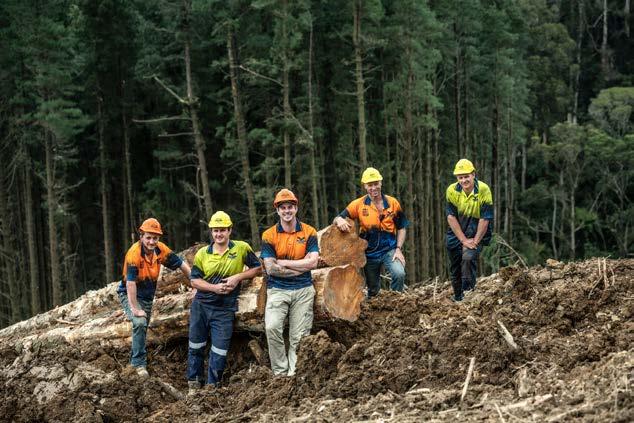
ket through the Emissions Reduction Fund, which will further reduce the investment burden for new plantations and has the potential to make a significant contribution to Australia’s emissions reduction goal of net zero by 2050.
Achieving one billion new timber trees in the ground by 2030 is a top priority for AFPA and its members and it should be a top priority for the national cabinet. AFPA believes we need a national plan, led by the Commonwealth and in partnership with the states, on how we will achieve this goal.
That is why AFPA is working with the Federal Government on rolling out these policies as soon as possible so that we can start making progress on the billion trees goal. After almost a decade of plantation decline, we have no time to waste to turn this around.
Victorian regional communities are being dealt the brunt of brutal job and skills losses since the timber supply issues stemming from a Supreme Court order in November 2022 locking up Victoria’s native forests causing mills to close down.
It was announced in 2019 by the State Government that the native timber industry would be phased out by 2030 and since then activists have been relentless in attempting to speed up the process by taking out court injunctions stopping timber harvesting operations leading to short supply.
“The loss of jobs in these rural Victorian communities are huge and they are very real,” Timber Towns Victoria President Karen Stephens said.
“Haulage operators, timber harvesters, industry contractors, mill workers – these are real people, and this is their livelihoods.
“They don’t know what to do, where to turn. In the town of Orbost for example, we know that almost a quarter of their jobs are going to be directly hit by the immediate lack of timber supply and the indirect jobs hit will be many more,” Cr Stephens said.
“These communities are facing a bleak future and they are enduring unnecessary stress and worry for themselves and their families.”
Cr Stephens said the slow, grinding will of any movement by the Victorian State Government to fix the Timber Code of Practice and avoid continual third-party litigation against VicForests was resulting in people’s livelihoods “going down the gurgler”.

Timber Towns Victoria member Cr Sonia Buckley from the East Gippsland Shire Council said the region needed local timber, local jobs, and best industry management practices which still required reform.
“This can and must be achieved,” she said.
“What is needed is the will of the State Government which sadly under the Andrews Government is not currently present, nor has any evidence been presented by Premier Andrews as to why the decision has been made.”
In Tasmania, we are fortunate to have an expansive plantation estate already, which is made up of 144,000ha hardwood and 26,000ha of softwood on private land, and 28,000ha hardwood and 48,000ha softwood on public land.
To plant more trees farmers on private land need to be educated on the reasons to grow commercially viable trees on their farms.
Unfortunately, there is some resistance to this.
Some farmers still remember the issues that were created when they grew trees under the managed investment schemes during the early-2000s. But the industry is not resting on its laurels. Now, with campaigns like Tree Alliance – which promotes planting the right trees in the right place – we are showing how creating the right mix between location and species, can increase farm productivity, improve the carbon balance, and create high value timber
products. For Tasmania, it isn’t about what is stopping the 1 billion trees plan, but rather harnessing private landowners and farmers to see the benefits of planting trees for the benefit of their whole farm.
Justin Law:
The idea of planting 1 billion trees seems unlikely even to someone with limited knowledge of forestry. It appears to be the same issue as creating hardwood timber plantations – where
is the land to plant all these trees? When you consider that to achieve healthy, mature trees – assuming this the point of the exercise – you would be limited to 500 trees per hectare. So you would need to find two million ha of land which is capable of sustaining trees (soil type, etc) that isn’t being used for anything else. Then you need to have expert site preparation and weed control – extrapolate that over 2m ha and calculate the costs.
to kick-start it?
Nick Steel
Increasing our plantation stock in Tasmania is already starting, with several key initiatives underway.
For example, SFM is managing a program called ActivAcre, which aims to plant 15,000 hectares of trees over a five-year period.
ActivAcre is succeeding as it’s working with farmers to create a regular income for

their businesses, as well as enabling them to share in the benefits of both timber and carbon markets.
The key to success in achieving our share of the one billion tree plan isn’t just the actual planting of more trees – it’s about utilising programs like ActivAcre and Tree Alliance to grow the market for planting commercial trees on new land.
Justin LawFind two million hectares of land for a start. I can’t help but imagine this as an episode of the excellent ABC comedy series Utopia. Some marketing department does a bit of market research to find that people want trees so we’re not just going to plant a few trees, we’re going to plant ONE BILLION TREES! And as so
few people understand the barest basics of silviculture (otherwise Australian forestry wouldn’t be so poorly treated), a government which promises such an outrageously unachievable goal isn’t questioned. Not only that, whenever anyone asks what the government is doing about climate change, this white elephant is what they’ll point to.

Nick Steel
Put simply, the risk is to sovereign capability. As we exit the Coronavirus pandemic, we have seen exploding demand for fibre-based essential products, as well as the record global demand for timber products in the building industry. This increasing demand has highlighted the importance of being self-sufficient in Tasmania’s, as well as Australia’s, forest product needs.
This means, to become more selfsufficient, the forest products industry must plant more production trees - to minimise the reliance of imported timber and wooden products.
A critical part of meeting the Tasmanian Government’s housing strategy of 10,000 new homes by 2032, and the Federal Government’s plan to build one million new homes by 2030, will be our local forest and timber industry.
Bipartisan support in Federal Parliament to the ambitious plan to plant an additional one billion trees to secure Australia’s future fibre ought to be commended but it’s time to rethink how we move this plan from policy to plantation.

Despite the Federal Government’s $87 million investment in a tree establishment fund, the reality is that it is the State Government’s responsibility to provide the framework to unlock land for new plantation estate.
This is why the critical pathway forward is for Federal Forestry Minister, Murray Watt, to secure a commitment from the states and territories on a national plan to unlock plantation growth.
The simple, unescapable truth is that global fibre demand is escalating and forecast to quadruple by 2050, meaning, and if we want to meet our future fibre needs at the same time as working to stop global deforestation, we need to get more trees in the ground and we need to do it now.
By planting more plantation estate, we secure our future sovereign capability to meet our fibre requirements without relying on imports, such as the framing timber used to build houses or pallets that transport our food from farmers to supermarket shelves, or even the paper that we write on.
It’s important to highlight that not only does our forest industries provide us much needed essentials in
 Nathan Paine Chief Executive Officer SAFPA
Nathan Paine Chief Executive Officer SAFPA

everyday life, but every tree that we plant is a step closer to a greener climate by sequestering carbon from the atmosphere.
As the Chubb Review eloquently explained, “After experimentation and speculation for decades, the only pathway known to science that has the immediate capacity to remove GHG (CO2) from the atmosphere at scale is photosynthesis: the mechanism by which plants and some other organisms use light, CO2 and water to create energy (stored as sugars) to fuel cellular activity and growth.”
That statement is a clear and unambiguous boost for the benefit of planting production trees.
More trees means more carbon sequestered, more jobs created in domestic processing and more houses that can be built and it is time to get those one billion trees into the ground.
When you add the ever-increasing global demand for renewable forest products that is forecast to quadruple by 2050, our future must be about meeting the one billion trees plan.
Justin Law
The ramifications are that millions, if not billions, of taxpayer money will be wasted on a pie-inthe-sky scheme which can never be achieved. There is already a
program called Greening Australia which is ostensibly the same thing and at least one forestry expert we know says that plantation sites are overgrown with weeds giving the plantings little chance of survival. Some have even been slashed. Meanwhile, timber communities are suffering while the native forestry sector is strangled to death by backwards thinking policies and empty promises that planting trees will somehow save thousands of regional jobs.
IN the face of a climate likely to become hotter and drier in the future, and with bushfires continuing to pose a significant threat, a variety of forestry-related research initiatives are currently underway across Australia.
As an industry, forestry is particularly vulnerable to bushfire threat, with the associated risks having the potential to impact plantation companies, native forest managers, wood processors and manufacturers in a variety of ways.
The latest episode of FWPA’s WoodChat podcast series therefore focuses on a recently-completed FWPAsupported research project aimed at increasing the industry’s capacity to minimise the impacts of future bushfire events. This work is focused on updating fuel accumulation and fire spread models for Australian forestry plantations. The project was co-funded by most of Australia’s large plantation managers, with matching funding from the Australian Government.
“A better understanding of how fuel accumulates over time in plantations means improved performance of fire behaviour simulators and, in turn, more accurate predictions of fire risk for plantation owners,” said Dr Kate Parkins of the University of Melbourne’s School of Ecosystem and Forest Sciences FLARE (FLAmes to REgimes) Wildfire Research Group, who led the research and is interviewed during the episode.
“Our results indicate that fuel loads have previously been under-predicted at key times during a rotation. This suggests that, in some cases, landscape-scale fire risk in areas with plantations may also have been underestimated.
“As part of our research, we explored future fire risk across different growing regions and under different climate projections. This enabled us to quantify where in the landscape and under what conditions fire risk will be at its highest.
“This information can be used by plantation owners to guide strategic fuel management and minimise future fire risk,” Parkins said.

Al Gore coined the term an ‘inconvenient truth’ in his eponymous 2006 documentary.
It is an apt description of the practice of fumigation around the world. In an era of global trade in forestry products, where invasive pests can be inadvertently imported, it is an essential activity to ensure biosecurity. Fumigators are a critical line of defence against

such pests, which have the potential to harm native plant life, affect economies, and hinder the environmental functions that healthy forests provide.
The threats and associated costs are real – in 2018, over 6 million acres of trees died because of forest pests or disease. The maximum potential economic impact to the US from potential imports of the Asian Longhorn Beetle is estimated to
be in the order of $669bn through tree mortality. Suppressing a 1996 infestation of the pest in New York State cost local authorities more than $4m.
However, the chemicals traditionally used as fumigants to protect our natural environment, methyl bromide and sulfuryl fluoride, are in fact incredibly harmful to our planet.
Methyl bromide is an ozone-depleting substance,
more than 50 times as reactive in ozone depletion as bromine. While the United Nations agreed to phased it out by 2015 through the Montreal protocol agreement, it is still readily used by many countries under agreed quarantine exemptions while recent data alarmingly suggest growing use in Australia, China and India.
Governments seeking to replace methyl bromide – the EU, for example, has banned its use within its borders – increasingly turn to sulfuryl fluoride. However as recent assessments demonstrate, sulfuryl fluoride is a potent synthetic greenhouse gas, dubbed a “climate killer” by the scientific community. Every kilogram of sulfuryl fluoride used has a 100-year Global Warming Potential of over 4 tonnes of CO2. Such countries are, under the auspices of regulatory authorities, simply swapping one environmentally destructive chemical for another.
Despite the significant environmental harms they cause, both methyl bromide and sulfuryl fluoride fall out of the regulatory rubric: neither chemical is part of the Kyoto Protocol or the Paris Agreement,
so there are no global targets to reduce emissions.
As a result, around 11,000 tonnes of methyl bromide and 3000 tonnes of sulfuryl fluoride continue to be used every year despite their detrimental impacts on the atmosphere. Amid the ever-worsening climate crisis, the continued reliance of both chemicals is unsustainable.
Fortunately, a sustainable alternative, which has gone through extensive scrutiny and research, is available. Ethanedinitrile (or EDN) is currently the only economically viable and environmentally benign alternative to methyl bromide and sulfuryl fluoride which is also highly efficacious against numerous pest types. Its use is slowly growing around the world.
Yet the biggest barrier to the introduction of alternatives to methyl bromide and sulfuryl fluoride can be posed by regulators and Governments themselves. New products such as EDN can face an incredibly high bar for introduction, even when supported by extensive and reliable data, and a lack of agreement on common evaluation criteria creates an ever-growing web of

divergent regulatory pathways. Where such data and research is available, Governments and regulators should follow the facts. We currently have a situation where it can be easier to continue to permit – and sometimes even require – the use of chemicals which are known to be incredibly harmful for both people and planet, rather than introduce new environmentally sustainable alternatives. This must be urgently addressed.
[There is in fact more and better data on the efficacy and environmental profile of EDN than methyl bromide or sulfuryl fluoride when they were first introduced. Regulators should follow the facts.]
Fortunately, some do. In the AsiaPacific region, EDN is used in both South Korea and Malaysia, and it is used under emergency permit in the Czech Republic. From July this year, New Zealand permitted the importation and use of EDN, in a move that was welcomed by the country’s forestry sector. In October, Turkey also registered EDN for use on imported logs.
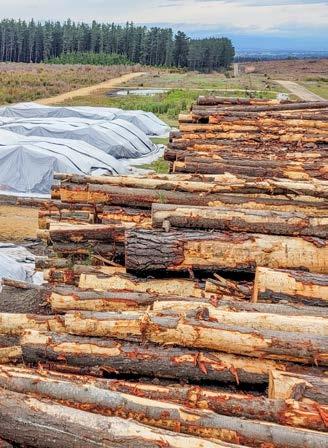
While these countries should be lauded for their efforts, internation-
al bodies and Governments elsewhere must act faster to safeguard both continued trade in essential commodities as well as the environment. Speeding up the regulatory process for those seeking to register and use alternative fumigants with a stronger environmental profile and backed by extensive and reliable datasets, such as EDN, would be a start on this journey.
For too long, fumigation has been a regulatory blind spot for many governments, and it has never been more crucial that we transition away to alternative products that do not damage the atmosphere. Bringing in new and sustainable alternatives should not be harder than phasing out products we know are harmful to our planet.
Protecting our natural environment is important, but it should not cost the earth.
Adnan Uzunovic has been senior researcher for over 20 years in a Canadian Wood research Institute, and is an Adjunct Professor at the Department of Forest and Conservation Sciences at the University of British Columbia.


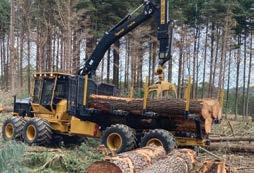



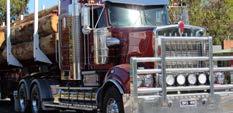








The Heyfield Timber Festival committee is delighted with the success of the event last weekend and have thanked everyone who attended the weekend and showed support for the event.

“We would also like to say a huge thank you to our sponsors, local community groups, and volunteers that helped us over the whole weekend,” the committee said.
“It’s so great to see everyone enjoy themselves and to see everything come together over the weekend.
“We hope you all enjoyed the weekend and we look forward to hosting another event next year.”


Inquiry ‘too brief’
New Zealand’s Forest Owners Association says the twomonth inquiry into land use in Tairāwhiti doesn’t give enough time or depth to find solutions.
The Prime Minister, Chris Hipkins has announced the government would be launching a Ministerial level Inquiry into land use in the region, following the demands of a local petition.
Forest Owners Association
President, Grant Dodson, says the two-month time scale for the Tairāwhiti Inquiry is too brief to properly consider the intersection of all land uses impacted and the considerable science that needs to be reviewed.
IRG meeting in Cairns
AUSTRALIA will host the International Research Group on Wood Protection (IRG) in Cairns from May 28 to June 2.
The IRG is the peak world body related to timber durability research and each conference brings together more than 250 researchers from 3040 countries to discuss new developments in the field.
Information about the meeting and registration is available at www.irg-wp.com/ IRG54/index.html
ForestSAT set for 2024
Rotorua and Whakarewarewa Forest will be the backdrop to a global forestry conference that is set to attract up to 500 remote sensing specialists to the city in just over 18 months.
Scion has successfully secured a bid to host ForestSAT 2024, the most prestigious international conference on the application of remote sensing technologies for forest monitoring and modelling.
Previous conferences have been held in Germany, USA, Chile, Italy, Spain, France, Sweden and Scotland. For the first time the conference will be in Australasia over five days, starting 9 September 2024.
Apology
The February edition of Australian Forests & Timber News contained a report on Ironwood Australia’s activities in Taree. Unfortunately due to a productuion error the wrong pictures were used in the story. Australian Forests & Timber News apologies to Ironwood Australia for any embarrassement.
In 2019, Private Forests Tasmania announced seven Tasmanian producers who would participate in the Demonstration Sites project.
The project allocated $600,000 in funding to help establish and integrate commercial trees into the properties, and to develop landscape-scale best practice commercial forestry plantings for demonstration purposes.
Co-funded by Private Forests Tasmania, the federal government and primary producers, the project saw planting begin in the late winter/spring of 2021, which resulted in more than 212,000 seedlings planted in the form of 90 hectares of shelterbelts and 110 hectares of woodlots.
We know that the diversification of existing agricultural ventures to include private forestry plantations provides landowners with increased resilience to both changing climate conditions and challenging global trade environments.
For the Demonstrations Sites project, trees were integrated into farming enterprises that included prime lamb, wool, grass seed, cereal grains, forestry, aquaculture, dairy, beef, cropping, seed growing and potential future horticultural crops.
Fulham: Planting trees to benefit the future
Fulham farm is a 3000acre grazing farm on the Southeast Coast of Dunalley and has been owned and operated by the Gray family since 1926.
Father and son farmers, Sandy and Tom Gray, have both lived the majority of their lives on the farm and have run a variety of enterprises over the years, including wool, fat lambs, angus beef cattle, olives and oysters.
Sandy has been planting trees on the Fulham farm for around 30 years—between 500 and 1000 trees each year of mixed species—and has long been aware of the various ben-
efits that trees provide. But, after losing most of the trees to the devastating bush fires of 2013, Sandy and Tom wanted to strategically replant trees to safeguard for the future.
“We really wanted to fast track planting more trees as quickly as possible. We were also looking to diversify from having mixed species shelterbelts to something that is commercially viable.”
With guidance from Private Forests Tasmania, Sandy and Tom planted 20 hectares of trees to negate the prevailing westerly winds at Fulham and provide shelter for lambing, sheep and other stock.
Private Forests Tasmania met with Sandy and Tom to devise a tree-planting plan that would best suit their property, taking into account the soil type, wind direction, paddocks most suited for grazing and other benefits the trees may provide.
“We gained vast new knowledge from being involved in the Private Forests Tasmania Demonstration Site project.
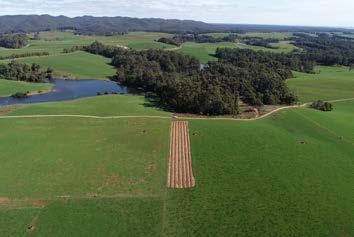
We are not scientists, we are farmers, so it has been really beneficial to work together with the experts at Private Forests Tasmania.”
Looking to the long term,
Sandy and Tom can see the tress as providing huge benefits to farms, not only aesthetically but environmentally. With the support of the Demonstration Sites project, Fulham Farm has been able to plant 18 hectares of shelterbelts, and the seeds for a bright future.
Gunningham: Where encouraging biodiversity is common sense
Gunningham Family Farms is a fifth-generation dairy farming business based around the Shakespeare Hills. Moving from South-west England to North-west Tasmania over 20 years ago, owners Matthew and Pip Gunningham saw an opportunity to establish a dairy farm in the top corner of the state, which now produces organic milk and pasture raised, free-range eggs.
Matthew has long recognised the importance of biodiversity in the pasture and has been working to add more diversity into the farm’s ecosystem.
The Demonstration Sites project has meant that the Gunninghams have been able to benefit from expert guidance along the way.
“We are thrilled with the help and support we have received.
● Winton: Campbell Town
● Logan: Evandale
● Gunningham: Montumana
● Kenilworth: Campbell Town
● The Back Run: Ellendale
● Chester: Selbourne
● Fulham: Dunalley
“We know a lot more than we did 12 months ago.”
The Demonstration Site project supported the planting of 22.39 hectares of trees in strategic zones across the property that made sense to the farm’s location and goals, such as establishing shelterbelts to help protect livestock and to increase pasture productivity.
Matthew Gunningham believes that integration of trees has made perfect sense for the farm’s biodiversity.
“The idea of just farming monoculture, it doesn’t
THE idea of applying for a scholarship can be overwhelming for some, however Timber Queensland’s Growth Scholarship program aims to make it a simple, accessible and fair process.
And you don’t need to be a forest scientist to apply – but if you are you can apply as well.
Open to early career professionals (18 – 45 years) who reside in Queensland, Growth Scholarships provide financial assistance (e.g., cost of course/fees, travel, time away from a job) for a learning project.
A learning project can include informal and formal experiences and innovation learnings, such as assistance with on-the-job training, short courses, study tours, components/units of formal qualifications, attendance at conferences and events, short term work placements and/or secondments to gain experience.
With Awards ranging from $10, 000 to $2500 you can think big and suggest an overseas study tour or consider doing a short course to help you improve your knowledge and advance your career prospects.
Timber Queensland’s Strategic Relations Manager Clarissa Brandt said the inaugural program invited early and mid-career professionals and skilled workers to submit details of a proposed learning project that would enhance their career and benefit local industry.
● The Chester property in the north of Tasmania near Selbourne make sense. One of the key outcomes of being involved in this project is that we will have a much more diverse ecosystem on the farm.”

The story of Gunningham Family Farms is an example of the kind of opportunities available to dairy farmers to be a key part of commercial tree planting, which, with the right support and planning, can be integrated with successful commercial dairy operations.
Matthew says that tree planting has been a learning process, but one that he would recommend to other farmers considering the benefits that trees could deliver to their own farms.
“I would definitely encourage other farmers to consider planting trees. We’re 100 per cent convinced that this is appropriate for lots of farms.”
The Back Run:
Transforming a poorly performing plantation
The Back Run is a Derwent Valley farm owned by Tom and Sarah Clark, producing sheep cattle and brassica seed crops.
In 2019, Tom and Sarah purchased an old 80-hectare block adjoining their existing property, which had a large woodlot area of Eucalyptus Nitens. The established trees were performing badly and were not
suited to the area, its altitude or soil type.
With the support of the Demonstration Sites project, the Clarks were able to replace the poorly performing plantation with a woodlot area, plus some shelterbelts around spaces that are being returned to paddocks.
Last year, a 35-hectare area was planted with 37,600 open-rooted Pinus Radiata seedlings, sourced from Lanoma Forest Nursery.
This year, an additional four hectares of Pinus Radiata shelterbelt and 10 hectares of woodlot has been established.
To maximise the benefits of the trees, the Clarks have enlisted the services of Mid-
way Tasmania and Climate
Friendly to potentially receive an early income from carbon farming, as well as a longer term income from sustainable forest products.
The first source of income arises from the value of the carbon stored by the trees as they grow, generating carbon offsets, and the second source of income results from the value of the forest products at harvest time.
The project at The Back Run goes to show just how important the selection of species is to a successful planting, as well as the multiple, real-time benefits of trees as they mature.
“To have a timber engineer, an operations and production worker, a forester and a forest scientist receive awards met one of the goals that Timber Queensland and Michael Kennedy, CEO of Scholarship Foundation Partner Kennedy’s Timber, put in place for the Awards,” she said.
2023 - 2024 Growth Scholarship applications open on 28 March and close on 30 June. The awards on offer are the Kennedy’s Timber Award - $10 000, HQPlantations Award - $5000, AKD Award - $5000 and the DTM Timber Award - $2500. Learn more about the Growth Scholarships at https://www.timberqueensland.com.au/News/GrowthScholarships.aspx
Komatsu Forest (KF) has long thought the value of hydraulic excavators for forest applications had not met its true potential. This was especially highlighted in the New Zealand market where roadside operations dominated their market due to the restrictions of soil types, steep terrain and cost restraints.
The Komatsu excavators with their unique compensated load sense hydraulic systems were thought to be very suitable for forest applications especially the 270LC/300LC/400LC models. Therefore, several years back KF started to work with various NZ after-market specialists for forestry cabs, guarding packages, high/wide undercarriages and boom modifications, all to meet the NZ local requirements.
This ultimately led to a close association with EMS
especially as they were the leaders for wood extraction methods with their Tractionline and Harvestline products which happen to be a good match for the Komatsu PC300LC/400LC respectively. In addition Active Engineering services were also engaged for the last 10 years and have been one of KF’s key suppliers when it comes to all the different styles of guarding packages.
Unfortunately, over time the demand for superior excavator modifications has led to ever increasing costs reaching the point where they lost their cost advantage over purposebuilt track carriers. This led Komatsu Forest P/L to
approach Komatsu Ltd (Japan) to assist in developing forestry updates to produce a more harmonious product for forest applications. Factory fitted forestry options would be more cost effective and greatly reduce lead time to the end user.
“Increased local costings meant there was no other decision but to pursue a factory solution,” said Komatsu Forest managing director Brett Jones who has been the main driver for the development of factory solutions.
The first decision was to design and manufacture a high wide track frame with all the relevant features which was made easy as the PC270LC-8 and PC300LC-8 already share the same standard track frame. This made it a very cost-effective project by not having to design two track frames. Following the completion of
the HW track frame, it was then decided to pursue a suitable factory boom option, in this case we had to design two different size boom sets for the PC270LC8HW and PC300LC-8HW.
“These two major options have been a real game changer when it comes to modifying an excavator for a forestry application,” Brett said.

The factory track frames and boom sets have now been installed and tested in the field since they were completed in late 2020, to date the customer response and acceptance of these products has been exceptional.
In addition to the former two projects Komatsu Ltd have continued to engage KF to design and development many additional features, like an IQAN crane control system and the Timberpro style high per-
formance cooling package. The latest development from Komatsu Ltd is a new design main hydraulic pump for the PC400LC-8, this pump is completely new and offers a thru drive for an additional aux pump which is now being used to run the reversing fan motor or it can be used to run a disc saw.
“This level of factory development shows the commitment Komatsu is willing to make when it comes to the forestry industry development,” Brett said.
“Many of these options have always been available at local level in some format but needed to be carried out in a more cost-effective manner.”
The development between KF and the Komatsu Osaka Excavator Factory has achieved the required outcome for the following options:
: The 850mm high wide track frame was developed directly with the EMS engineering team in NZ. This included a reinforced HW track frame with a heavy duty slew guard along with a robust set of track skies and track motor covers.
Forest Boom Set : The Working Gear ( WG ) boom set was developed in Japan and refined in Australia by Tim Reen and Brett Jones. There were a number of changes made in Aust, ranging from all the purpose- built flange piping to the working range of the boom geometry and 330mm boom tip geometry.
This boom design can accept every available grapple harvester, directional felling head, and log grapple that is currently available on the market.
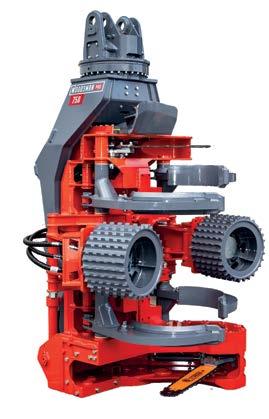
Forest Cabin : The Komatsu forestry cabin has been developed in Japan with the interface design being engineered to include rubber isolators. There is also the option to install the EMS and Active cabin range, as both companies offer a very good
quality standard side door cabin with the option of a rear entry cabin.
Additional new developments are;


Cooling Package: There are two main options when it comes to the cooling packages, the standard cooling system with an aux hydraulic cooler for generally demanding attachments. Alternatively, the purpose built forestry package which totally replaces the original cooling package with side by side AKG cooling package which comes standard with a hydraulic reversing fan.
Bump Rails: KF offer their own bump rail solution which has been designed to be incorporated with the Komatsu Log Loader cabin. There are also a range of different bump rail options from multiple guarding shops with EMS and Active being key suppliers for Komatsu Forest in NZ and Aust. Heavy Duty Panels : KF do have multiple HD side door options including its own design which are manufactured and installed at a local level to maintain flexibility with every machine. Also, KF has developed a new gullwing with EMS for
the PC300LC-8HW to accept the purpose built cooling package, this cooler package and gullwing option are a major breakthrough when it comes to an excavator being truly purpose built for forestry.

IQAN Controls : KF have developed two levels of IQAN control systems for the Komatsu excavator, one being just for the crane circuits and aux requirements like managing an auto reversing fan and the second being for a total machine control system.
Today, Australian and New Zealand logging contractors
are able to order the Komatsu PC270HW / PC300HW with any combination of the options listed, depending on their requirements or budget restrictions to provide an economical productive forest track machine. In addition, the Komatsu PC400HW is in a class of its own for those heavy-duty operations requiring the very heavy attachments e.g Harvestline, SouthStar 600/630 or Waratah 625/626.
“All of the above machines and options will now provide contractors with a very cost-effective logging solution,” Brett said.

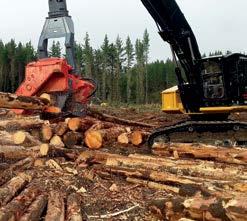
Ponsse has delivered its 19,000th forest machine to Scottish long-term customer Elliot Henderson Ltd, with the Royal Burgh of Annan Pipe Band playing in the background.
The Ponsse Scorpion Giant harvester with H8 harvester head will work at logging sites in the Scottish Borders and Scottish Lowlands.
“Thank you to the Elliot Henderson group and the Royal Burgh of Annan Pipe Band for coming to Vieremä to celebrate the 19,000th machine milestone with us. I understand this is the first time a pipe band has played at Vieremä village, which makes this day even more special for all of us, as this is Ponsse UK’s first milestone machine. This is a day that we will remember for years to come,” Gary Glendinning, Managing Director Ponsse UK, said.
The Ponsse Scorpion Giant is a versatile harvester for demanding conditions.

Scorpion Giant can be equipped with either the H8 harvester head or with any of Ponsse’s smaller harvester heads. Scorpion Giant features many solutions familiar from the Scorpion product range, which has been developed even further, including an increased tractive force and an even more powerful C50+ crane. The cabin offers excellent visibility to the logging site, and the machine includes advanced active levelling and suspension systems.
Ponsse Scorpion Giant is equipped with a one-piece windscreen that extends to the roof of the cabin. As a result, visibility from the cabin is even better, and working is safe in all conditions. The cabin is like a practical and quiet office with a view, developed to support the operator’s comfort and wellbeing.
Elliot Henderson Ltd is based in Selkirk in Scotland. The company started more than 35 years ago, planting trees with a small squad of
men. Over the years, the business has grown and diversified into forestry, construction, and scaffolding. Today, Elliot Henderson Ltd comprises more than 40 forest machines which can undertake clear fell, thinning, steep ground harvesting operations, ground preparation or the construction of forest roads. Elliot Henderson Ltd also has the capability for site brash clearance, stump removal and servicing the biomass industry. The company is also a founding member of the Forest Industry Safety Accord and is a member of the Forestry Contractors Association.
With Elliot Henderson Ltd being a long-standing customer for well over 20 years, it’s a fitting tribute to the relationship between the customer and manufacturer that the landmark 19,000th machine is joining the fleet.

“Elliot Henderson Ltd has always been at the forefront of new machine releases
over the years, which in turn keeps the harvesting fleet productive and at the vanguard of innovation,” Neil Purves, Director of Harvesting for Elliot Henderson Group said.
“We are excited to be adding this Scorpion Giant to the fleet. This machine will go straight to work in the windblow resulting from Storm Arwen and we feel the extra power and H8 head will benefit us in this application. We look forward to seeing what it can do! We are currently running PONSSE Scorpion, Ergo, three Elephants and one Buffalo.”
Ponsse UK was established in 1996, and since 2017, the company has operated at Annan, Scotland. The first Ponsse forest machine was already delivered to the country in 1994, and the fleet now comprises nearly 400 Ponsse machines. The Annan service centre is a workplace for about 30 Ponsse professionals.

Our CONNECTED FOREST™ solutions are designed to improve productivity and streamline all forestry operations.
Our CONNECTED FOREST™ solutions are designed to improve productivity and streamline all forestry operations.
Our portfolio provides solutions to manage the full rawmaterials cycle: planning, planting, growing, harvesting, transportation and processing.
Our portfolio provides solutions to manage the full rawmaterials cycle: planning, planting, growing, harvesting, transportation and processing.
Trimble Forestry offers the world’s leading integrated software and solutions for collecting, communicating and analyzing information across and throughout the forestry business, all in real time.
Trimble Forestry offers the world’s leading integrated software and solutions for collecting, communicating and analyzing information across and throughout the forestry business, all in real time.
To learn more about Trimble’s Connected Forest solution and to request a demonstration visit forestry. trimble.com, email forestrysales@trimble.com or contact:
To learn more about Trimble’s Connected Forest solution and to request a demonstration visit forestry. trimble.com, email forestrysales@trimble.com or contact:
Aaron Ford
Aaron Ford
APAC Regional Sales Manager, Trimble Forestry
APAC Regional Sales Manager, Trimble Forestry


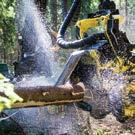

02 6658 1478 Direct 0477 007 134 Mobile
02 6658 1478 Direct 0477 007 134 Mobile
aaron_ford@trimble.com
aaron_ford@trimble.com
Lakeland Steel has been a leader in the design and manufacture of custom conveying systems for the New Zealand logging industry since 1976.
While the company originated in the forestry sector, they now offer custom-built materials handling equipment and end-to-end engineering solutions for sawmills as well as bulk material handling and scrap metal companies.
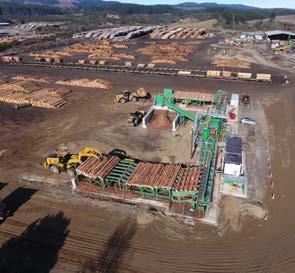
“We pride ourselves on our bespoke design capabilities for complex briefs where unique solutions are required,” Cory Leatherland, Lakeland Steel owner said.
“Because of the complexity of our solutions, it is crucial that our parts suppliers have the technical expertise to understand our requirements, provide high-quality products and offer insights outside of our own capabilities.”
In Bonfiglioli, Lakeland Steel not only found a reliable heavy-duty parts supplier, but also a regular project collaborator. The company was impressed by Bonfiglioli’s tech-
nical know-how and prompt customer service.
“We had worked with other suppliers in the past, but as time went on, we began to increasingly steer our customers towards Bonfiglioli because of the levels of service and technical expertise that we received,” says Cory. “Now we use Bonfiglioli gearboxes - unless the customer specifies otherwise.”
“Our partnership with Lakeland Steel begins at the design stage. Here, we are able to is customise our solutions down to the exact specification of the brief,” said Paul Savage, New Zealand Sales Manager.
“As a customer, this early-stage assistance is invaluable - you’re going into the project with the specifications you need to ensure successful completion” adds Cory.
Lakeland Steel uses Bonfiglioli’s 300M Series Industrial Planetary Gearmotors for a range of heavyduty applications including:
- Roller conveyers
- Belt conveyers
- Stacking systems
JS-50 X6B NEW
CARRIAGES & SHORT-INFEED EDGERS
JS-50 WX TRIMMERS, EDGERS BUCKING & MORE
- Live floor hoppers
- Hoists
- Infeed systems
“The timber industry is extremely demanding on products and the 300M Planetary Series is robust enough to operate without downtime. The customisable 300M Series is ideally suited to a range of industries and applications because of its modular design,” says Paul.
Other features that make the 300M Planetary Series well-suited to the requirements of Lakeland Steel include:
- Top-class flexibility achieved by multiple outputs
- Input configurations available for all 20 sizes of the Planetary gearbox
- Higher shock load capacity
- Higher load distribution
- Higher transmissible torque
- Up to 20% higher reduction ratios

- Low maintenance costs
“With Bonfiglioli we truly get the best of both worlds: local stockholding, great customer service and the benefits of global expertise from a multinational,” says Cory. “The Bonfiglioli New Zealand team is small but agile – if we experience a breakdown, we often receive sameday service and someone from the team will arrive on-site to do what it takes to get the equipment back up and running or deliver a part.”
Cory also notes that the company prefers to work with suppliers who can provide insights that help aid the design process. “Over the course of our relationship with Bonfiglioli,
Paul has recommended gearboxes and mounting arrangements that we had not previously been familiar with and offered technical advice based on global applications he had seen within the Bonfiglioli group.”
Bonfiglioli’s global presence – particularly in Australia – has also been helpful to Lakeland Steel as the company has gone through a period of significant expansion. “We are looking to take on more Australian projects and it has been comforting to know that we will be able to experience the same quality of products and level of customer service when working with Bonfiglioli Australia,” he says.
While the New Zealand timber industry is booming, Australia took a significant knock from the bushfires of 2019, with experts estimating that up to 100,000 hectares or 10% of the country’s softwood plantations were destroyed by the devastating fires. The sector is also recovering from the effects of the COVID-19 pandemic, which suppressed demand for timber.
Lakeland Steel’s long-term relationship with Bonfiglioli New Zealand makes them uniquely positioned to capitalise on this strategic opening.
“Not only do we have the capability to increase output while retaining quality standards because of the production advantages offered by using the 300M Planetary Series, but we have the peace of mind of dealing with a supplier across borders who are familiar with our requirements,” he said.


Nokian Forest King F2 is absolutely the best choice for CTL machines using tracks or chains. Nokian Forest King TRS 2 is an optimum solution where traction and selfcleaning is everything. Both tyres have excellent durability and performance in the most demanding forestry work.
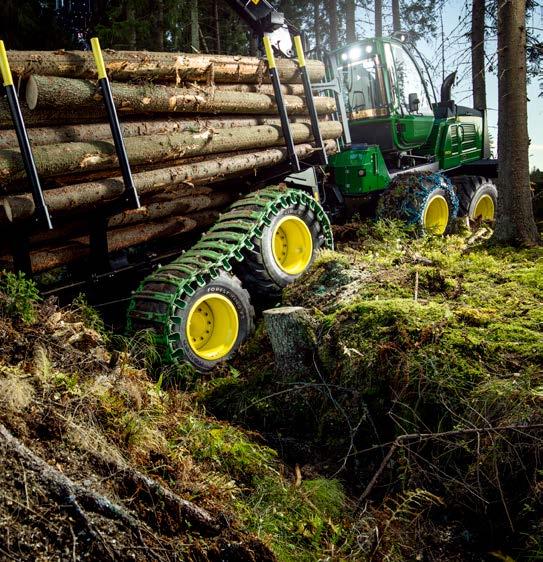
FAE has increased the productivity and efficiency of its BL5/EX forestry mulcher for excavators with the new BL MAX blade.
The new BL MAX blade is the ideal addition to the king of FAE’s mulchers for excavators with Bite Limiter Technology. This technology reduces power demand and promotes a consistent working speed, for excellent performance mulching any type of wood.
The new BL MAX blade features a large cutting surface, an optimized profile, ultra-strong materials, and special heat treatments that make it extremely efficient for shredding. The BL MAX blade can be sharpened to extend the life of the tooth.
The BL5/EX for 24-36 ton excavators, mulches vegetation up to 40 cm in diameter and has a working width of 160 cm. This head is ideal for handling and removing vegetation in wooded areas, especially when a large shredding capacity and fast operational speed is required. The rotor with Bite Limiter technology comes with special wear-resistant steel limiters that limit the teeth’s reach. This cuts down on power demand, promotes a consistent working speed, optimizes fuel consumption and ensures excellent performance when mulching any kind of wood. This machine can be equipped with FAE’s exclusive Sonic System, which keeps the operating machine and the FAE mulcher seamlessly aligned by automatic calibration. Every FAE user can easily access this technology with the FAE app for iOS and Android. The Sonic System continuously manages the mulcher’s hydraulic settings for a significant boost in overall productivity of up to 30%.
The new BL MAX blade is also an optional tooth for the 200/U forestry mulcher, which is available for the FAE PT-300 tracked carrier and other special high horsepower vehicles.
Not all quality tyres are made for the biggest and most powerful tractors. The Nokian TR Forest 2 tyre has a comprehensive size range has been a proven, reliable choice for light and medium weight forestry tractors.
Forestry work puts tractor tyres to the test. The demanding terrain calls for good cut and crack resistance, working stability and puncture protection. The Nokian TR Forest 2 tractor tyre combines decades of forestry experience with the latest tyre technology, offering excellent value for light and medium-weight tractors in forestry, landscaping and light mulching work.
“Forestry tractors have a significant role in forwarding and forest ground maintenance work”, says James Dickinson, General Manager of Tyres4U the exclusive distributor of Nokian Tyres for the Australian market.
“The Nokian TR Forest 2 tyre is designed to work in challenging terrain, helping users to get the most out of their machinery.”
Building on a tradition of excellence
The legacy of Nokian TR Forest tyres goes back a long time. “It has offered trouble-free performance in demanding applications”, says James Dickinson. “Forestry operators have trust
that it doesn’t let them down in the rocky terrain with tree stumps, debris and slippery conditions.”
Puncture resistant for trouble-free work
One of the main focus areas in developing the Nokian TR Forest 2 tractor tyre has been its cut and crack resistance and puncture protection. The thick layer of rubber compound made for forestry use offers a good protection. There is also a special shoulder armor design that protects the shoulder area from damage.

Another truly remarkable feature is the outstanding strength of the modern bias structure tyre carcass that incorporates punctureresisting reinforcements under the tread. Combined, these features make the overall tyre construction very strong for high-class puncture resistance.
Stable and versatile
Tyre stability is a desirable feature making work more accurate, comfortable and safer. The bias structure of the Nokian TR Forest 2 tractor tyre has excellent shock and swing absorbing characteristics. This results in steady performance in several different types of tractor work.
Versatile use of tractors is essential in forestry work. From wood forwarding to crushing, form light mulching to maintenance of forest terrain – reliable tyres help the tractor perform its best.
Nokian Tyres expertise in forestry tyres, combined with the modern bias technology and materials, has taken their products to the next level.
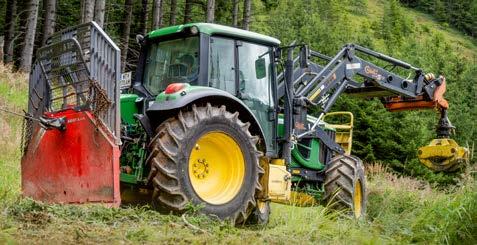
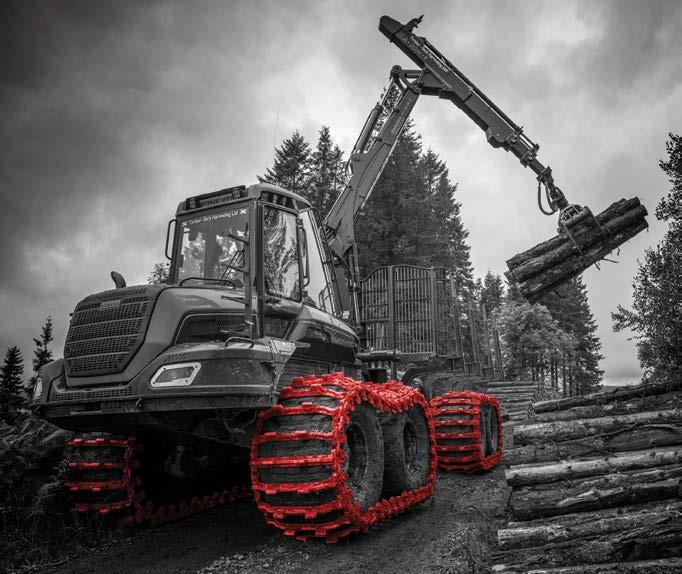
FXT is a balance between durability and grip, and features equal extensions on both sides of each track plate for additional side protection, flotation and stability. The FXT features the famous Rocky spikes, realigned for grip and maximising traction. These tracks are built for endurance and performance in all conditions and are suited to the heaviest Forwarders and six-wheel Skidders working on the toughest terrain.
FXT is a balance between durability and grip, and features equal extensions on both sides of each track plate for additional side protection, flotation and stability. The FXT features the famous Rocky spikes, realigned for grip and maximising traction. These tracks are built for endurance and performance in all conditions and are suited to the heaviest Forwarders and six-wheel Skidders working on the toughest terrain.

THE Prime Minister wants any Royal Commission into the recent bushfires to last for no more than six months, and to have a focus on hazard reduction.
There have been numerous inquiries into bushfires stretching back many years, with pretty much all of them saying we’ve got to have greater management of fire risk, fuel loads and hazard reduction burns.
However, despite State Governments agreeing to adopt the recommendations, little has been done to implement them.
But Mr Morrison said he was more optimistic about his proposed Royal Commission, which has attracted industry support from the Australian Forests Products Association as well as former Victorian Labor premier John Brumby.
2017
THE LAUNCH of a new $6 million Forestry Training and Skills Development Service, to be delivered by ForestWorks, highlights current confidence in the resurgent forestry sector in Tasmania.

Tasmanian Minister for Resources, Guy Barnett announced the new service to support the rebuilding and reskilling of the Tasmanian forest industry workforce.
Minister Barnett announced the new Training and Skills Development Service at a launch event hosted by McKay Timber in Launceston. The Tasmanian Training and Skills Development Service is funded by the Australian and Tasmanian Governments.
2012
STATE-OF-THE-ART Geographic Information System (GIS) technology that can create highly detailed 3D maps of entire forests is set to overhaul Australia’s $2.5 billion forestry industry, according to one of the nation’s leading spatial professionals.
The technology, from leading location intelligence specialists Esri Australia, was on display at SilviLaser 2011, an annual showcase of LIDAR, or light detection and ranging, technology and its applications in forestry.
Plantation thinning may not be new in the forestry sector, which has been thinning to improve tree growth and vigour for years.

But the operations being carried out by Forico in Tasmania’s northwest are racking up the benefits, continuing the development of forestry-based carbon methodology, growing construction timber, and pushing innovation boundaries.
Forestry and carbon
Forico is believed to be one of the first Australian forestry and asset management companies to register plantation forestry projects with the Clean Energy Regulator’s Emissions Reduction Fund (ERF). The company uses an Enterprise Valuation Model to identify operations with the potential to add value across its managed estate. In early 2022, modelling predicted that thinning trees between nine and twelve years of age would produce more substantial growth, suitable for sawlogs and the building timber or engineered wood products of the future.
Further investigation by Strategic Planning Manager Steven Butt and Sustainability Manager Simon Cook identified the opportunity to register operations under Schedule 2 of the ERF’s Plantation Forestry Method. This would generate carbon credits, the trees capturing more carbon in the resulting extra ten years of growth than would have been captured on a shorter rotation. Figures indicated that an extra hundred tonnes per hectare of carbon will be drawn down from the atmosphere and stored.
“We’ve all known for a long time that thinning trees creates results in greater carbon capture in the long term, with greater height and volume in the crop, better access to light and water and capacity to photosynthesise,” says Darren Herd, Forico’s General Manager of Plantation Performance. “What’s new here is the opportunity to convert a hardwood crop from short to long rotation,
while creating additional Natural Capital value in more carbon sequestration, with the costs supported by registering for Australian Carbon Credit Units.”
Specialist Harvest Machinery
The project was registered with the ERF in March 2022 and began in July, overseen by Forico’s Operations Forester Roger Ambrose. Forico appointed Tasmanian contractor Casegrande Lumber, whose Principal is Paul Morgan. Both he and Ambrose have extensive experience in commercial thinning operations. Casegrande was equipped with harvesters designed to rotate within their own footprint reducing the likelihood of damage to trees, and a long boom allowing for greater reach. This reduces the need for “outrows”, when an entire
row of trees is removed to allow passage, and results in less traffic across the site, reduced impact on soil and productivity, and fewer windrows, reducing the potential for storm damage.
Forestry and Innovation
Working with Private Forests Tasmania (PFT) and Senior Research Fellow Mauricio Acuna from the University of the Sunshine Coast (USC), Forico also facilitated a trial as part of the Wood Supply Co-investment Program supported by PFT, relating to Light Detection and Ranging (LiDAR) sensing technology. Results from two plantation plots were compared, a control plot in which the harvesting operator selected trees for extraction, and a plot in which trees were marked for harvest in a manner mimicking selection by sensing technol-
ogy. While results are still being collated, it is hoped that LiDAR will prove to be a highly effective means of streamlining thinning operations.
“There’s a distinct difference in the appearance of the plantations and the quality of the outcome,” says Forico’s Harvest Operations Manager for the Northwest, Mark Pearce. Lumber for the long-term With a view to long-term planning and diversification, growing plantation hardwood for a longer rotation aligns with one of Forico’s strategic goals, namely the investigation into downstream processing. The sawlogs and potential for lumber and engineered wood products from thinning operations ultimately addresses the emerging critical shortage of structural timber in Australia.
This is a unique opportunity to purchase a fully functioning timber mill, 450km west of Brisbane and easily accessible by road and rail. Situated on a 3.63ha^ site, this mill is complete with top-ofthe-line machinery (see full list online*) including dressing yard, water tanks and water trucks.



The mill processes timbers for manufacture of furniture products, flooring, cabinetry, wood-based panels, craft and toys. The supply chain is streamlined, timber is packed and transported to the Port of Brisbane.

